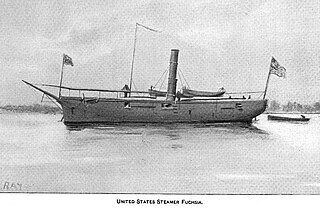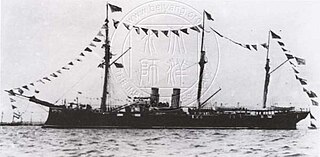
Kasuga Maru was a Japanese wooden paddle steamer warship of the Bakumatsu and early Meiji period, serving with the navy of Satsuma Domain, and later with the Imperial Japanese Navy. She was originally named Keangsoo, and was a wooden dispatch vessel built for the Imperial Chinese Navy. She was constructed in 1862 by Whites at Cowes, she formed part of the Lay-Osborn Flotilla during the Taiping Rebellion.

Sherard Osborn was a Royal Navy admiral and Arctic explorer.
USS Dai Ching was a steam gunboat in commissioned into service in the United States Navy in 1863. She served in the Union Navy during the American Civil War until her loss in 1865.

The Imperial Chinese Navy was the modern navy of the Qing dynasty of China established in 1875. An Imperial naval force in China first came into existence from 1132 during the Song dynasty and existed in some form until the end of the Qing dynasty in 1912. However, the name "Imperial Chinese Navy" usually only refers to the Qing navy that existed between 1875 and 1912, with "Imperial Chinese Navy" as its official English name.
USS Tulip was a 183-ton steamer acquired by the Union Navy during the American Civil War.

USS Fuchsia was a steamer acquired by the Union Navy during the American Civil War. She was used by the Navy to patrol navigable waterways of the Confederacy to prevent the South from trading with other countries.

The flag of the Qing dynasty was an emblem adopted in the late 19th century (1889) featuring the Azure Dragon on a plain yellow field with the red flaming pearl in the upper left corner. It became the first national flag of China and is usually referred to as the "Yellow Dragon Flag".

Nan Chen was an unprotected cruiser built for the Imperial Chinese Navy. She was built by Howaldtswerke-Deutsche Werft, Kiel, Germany, while her armament was installed by Armstrong Whitworth, Elswick, England. She was the lead ship of the Nan Chen class, alongside her sister vessel Nan Shui, which was based on the design of the cruiser Kai Chi. Nan Chen was considered to be obsolete by the Western Powers even at the time of her construction.
Confucius was an early armed riverboat of the Qing dynasty, and one of the earliest modern vessels of China.
Chun Ho is an early gunboat of the Qing Dynasty.
Hyson is an early gunboat of the Qing dynasty.
HMS Mohawk was a British Vigilant-class gunvessel launched in 1856.
Tientsin was a British-made dispatch boat launched in 1863.
Kwangtung was a British-made dispatch boat launched in 1863.

HMS Jasper was a British Algerine-class gunboat launched in 1857.

Nan Shui was an unprotected cruiser built for the Imperial Chinese Navy. She was built by Howaldtswerke-Deutsche Werft, Kiel, Germany, while her armament was installed by Armstrong Whitworth, Elswick, England. She, alongside her sister vessel Nan Chen, which was based on the design of the cruiser Kai Chi. Nan Shui was considered to be obsolete by the Western Powers even at the time of her construction.
Fei Lung was an early gunboat of the Qing Dynasty.

HMS Desperate was originally slated to be built to the Sampson designed steam vessel rated as a Steam Vessel First Class (SV1); however, the Admiralty, first rerated the vessels as First Class Sloops on 19 April 1845 then on the 9 May 1845, she was ordered as First-Class screw sloops to be built from a design of Sir William Symonds, Surveyor of the Navy. She would be a 10-gun vessel with 400 NHP engines. She served in the Baltic during the Crimean war, and as a store ship to Edward Augustus Inglefield's Arctic expedition. She was broken up by 1865.
HMS Vesuvius was initially a Steam Vessel second class designed by Sir William Symonds, Surveyor of the Navy, and built at Sheerness. She was commissioned and participated in the bombardment of Acre in 1840, during the Russian War she was in the Black Sea and the Sea of Azov in 1855. Her last overseas posting was in the West Indies. She was sold for breaking in June 1865.
HMS Alecto was an Alecto-class sloop designed by Sir William Symonds, Surveyor of the Navy. Originally classed as a steam vessel (SV3), her classification would be changed to a Third Class Sloop. She initially served in the Mediterranean, prior to her tug of war with the Rattler. She spent her time in the Americas and mainly on the anti-slavery patrol off the west coast of Africa. She was broken up in November 1865






